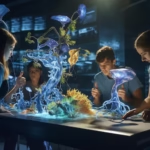I stand in front of a question written in obsidian shards. I don’t speak obsidian. I’m not sure anyone does. I’m not even sure Jimmie Durham does, and he’s the one who wrote it.
I try to translate.
“God! You’re,
the a do sad
ads (oa) ash…
bread as a broad goo?”
That can’t be it.
“Excuse me,” I beckon the 90-pound security boy over. He looks like a kid who likes to be first to the answer. “What do you suppose this says?”
He has a fresh haircut. He is brightened by a good challenge, I can tell.
His skin looks nice. Very little acne. No neck wrinkles like I’m getting yet. He makes me think of when I was a security boy in Tucson, sneaking food off the buffet table during private museum events so as to save money and avoid Jack in the Box when possible.
“I don’t know,” he says. “I’ve been trying to figure it out for two months.”
I believe he has. We try some more.
find a do dad
add (oa) aah…
About as abead soo?We’re unsatisfied, Security Boy and me. But he has friends. Two more teens on the job.
The girl:
“Dad! You’re
the mountain (she keys in on the triangle shape, the first to suggest pictograms as a possibility) do dad…”
She struggles as we do, giving up before going through the motions of vocalizing further nonsense.
The second boy just laughs and shakes his head. None of the four of us know. We drift apart and move on, but the first boy lingers, still searching for clues.
The presence of Durham’s mind seems to me to exist in a kind of procession, or series of processions, throughout the museum. The work is on the prowl, and in it there is a trickster present, sometimes explicitly, as in his Coyote skulls. Coyote, the omnipresent trickster of indigenous mythology, might also have something to say about who exactly Jimmie Durham is.
I imagine Durham himself as Coyote, not simply because of the native North American connection, but because Coyote, as a mythological figure, is an impersonator of others, and of the Creator Itself, an archetype that fits the nature of what artists do. So to find these skulls, for instance, mounted on stolen police blockades, is no meaningless gesture.
There is no thought or object, in the studio practice of Jimmie Durham, too small not to be quickly sketched, collected, or jotted down. The artist never seems to ask himself whether the thing he’s just done is art or not. In fact, he seems skeptical of Capital A Art, and, I imagine, of what art is for, and has been for, as a social function among the elite. The work is effective perhaps because he doesn’t question its art-ness, but, simply permits it to be whatever the hell else it is. In resisting easy translation into categories, its authenticity, speaking through earned wit and humor, is self-evident, and I begin to wonder how much of what else I see on an average evening of gallery openings retains this level of authenticity, encumbered, as it often is, with it’s own self-serious art-ness.
shape behind the scaffolding because I’ve been knee deep in the information in front of me for the past several months, something I just wrote about in the previous edition of HTGAS. Though I don’t yet know it’s an Andrea Bowers work, I read on the far left of the multi-colored wall display, “Energy Transfer Equity,” “Dakota Access,” etc. All the companies that own stake in the oil pipeline that protesters stood down at the end of the Obama administration only to leave and/or be evacuated at the start of the Trump administration. On the right side of the display, of course, are the innumerable banks around the world profiting from the interest on loans given to these companies to build and operate the pipeline.
Jimmie Durham was born in a Cherokee community in Arkansas and would later take on an important role in the American Indian Movement. In early 1973, the occupation of Wounded Knee began on Pine Ridge Indian Reservation in South Dakota. Jimmie Durham, who had been living in Mexico and then Europe, was, for the first time, compelled to return to the U.S. to participate in Civil Rights struggles for American Indians. In 74, Durham became the director of the New York office of the International Indian Treaty Council. Violence at Pine Ridge between protesters and law enforcement was a frequent occurrence throughout the 70’s and resulted in the deaths of over 300 American Indians and two FBI agents.
I am living in a time when it feels like everything I care about is under attack, and most of the time, by men who look like a fat ugly version of me twenty years from now. To tell the truth, I often loathe my own kind, if that is, in fact, who they are or I am.At the center of the world is an empty room, except for a desk, a rock that sits on it, and a man in a suit sitting behind it. His face is calm. Emotionless. His jacket is black, as is his tie. White shirt. His hands rest clasped on the desk as he waits.
A young woman approaches the man in the empty room at the center of the world, and places on his desk a simple little clock. She backs away.
He picks up a rock and smashes the clock, its pieces flying off the desk. He opens a drawer and produces a ledger, a stamp, and a pen. He signs the top sheet of paper, stamps it, and hands it back to the woman. She steps forward, grabs it, and exits the room.
There has been an exchange. Her property in exchange for a document.
Immediately after her, a young man steps up. He puts a plastic dinosaur on the man’s desk. Smashed with considerable effort on the man-in-the-suit’s part. Document signed and stamped.
Then someone with some kind of food.
Then someone with a guitar.
And so on. Each item smashed. Each accounted for. The same calm demeanor on the man’s face never changes.
expanse of snow along the Missouri River takes on an emotional quality that’s hard to describe. I have been following the Standing Rock protest for months and now I watch it end. I feel like a coward for not being there. This same fight happens over and over while most of us think of it as a thing of the past. Every fire I watch is some kind of “I told you so.” One has only to see the wall display behind the scaffold at the Hammer to know that there are simply too many rich people who influence policy standing to make gobs of loot. The pipeline isn’t going to be stopped.At the center of the world is a refrigerator. Rocks are hurled from out of nowhere and bash the white metal appliance over and over again until it’s deformed and wilted by innumerable dents.
At the center of the world, art finally comes into existence because it’s no longer meant to decorate the homes of the rich.Coyote, having gotten the joke, never stops laughing.








